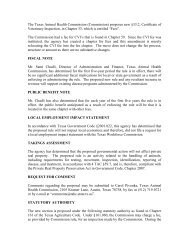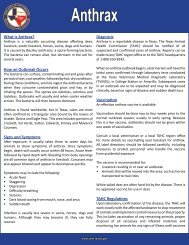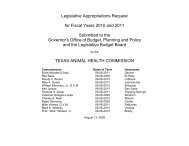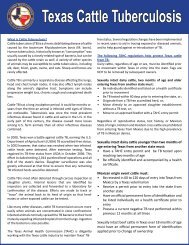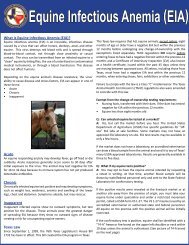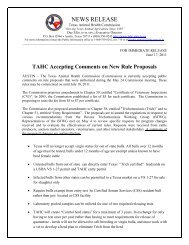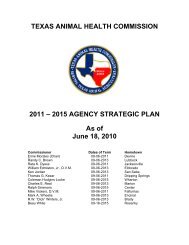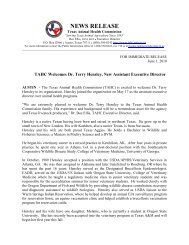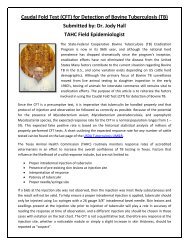TAHC Piroplasmosis Brochure - Texas Animal Health Commission
TAHC Piroplasmosis Brochure - Texas Animal Health Commission
TAHC Piroplasmosis Brochure - Texas Animal Health Commission
You also want an ePaper? Increase the reach of your titles
YUMPU automatically turns print PDFs into web optimized ePapers that Google loves.
TEXAS ANIMAL HEALTH COMMISSION• •Since1893SERVING TEXAS ANIMAL AGRICULTUREEquine <strong>Piroplasmosis</strong> (EP)What is Equine <strong>Piroplasmosis</strong>?Equine <strong>Piroplasmosis</strong> (EP) is a blood-borne protozoaldisease that affects horses, donkeys, mules, and zebras. EPis currently not considered endemic in <strong>Texas</strong> or the U.S.;however, isolated outbreaks of the disease have occurredin recent years. EP is not transmissible to humans.Signs and SymptomsOnce infected, an equine can take 7 to 22 days to showsigns of illness. Cases of EP can be mild or acute, dependingon the virulence of the protozoa. Acutely affected equinecan have fever, anemia, jaundiced mucous membranes,swollen abdomens, and labored breathing. Equinepiroplasmosis can also cause equine to have roughenedhair coats, constipation, and colic. In its milder form, EPcauses equine to appear weak and/or possess a lack ofappetite.TransmissionEP is a disease caused by the protozoa Babesia caballi orTheileria equi formerly Bebesia equi. The disease can betransmitted between horses or other equines by certainspecies of ticks, when they ingest blood from an infectedanimal and then bite an uninfected animal. It can also bespread through the transfer of blood during a transfusion,or through the use of contaminated needles and otherunsanitary animal husbandry practices. Moving hay,bedding, feed, and vegetation can transport ticks carryingthe protozoa. Intrauterine infection from mother to foalhas been reported.Several species of ticks in the U.S. are capable of spreadingEP. The spread of EP through ticks however has only beenseen in isolated areas in South <strong>Texas</strong>. Most cases of EPin other regions of <strong>Texas</strong> have been caused by the othercontaminated needles or instruments such as tattoo pliersand dental floats.Seek guidance from your private veterinarian beforegiving your horse any injectable treatments. ALWAYS usea fresh, sterile needle for every injection on your horsesand practice good tick control with an approved product.Border IssuesEP is found in many regions of the world, including partsof Africa, the Middle East, Asia, Europe, Central andSouth America, the Caribbean and Mexico. Internationalmovements of equine from foreign countries presentpotential risks for the introduction of EP into the U.S. Thelong border <strong>Texas</strong> shares with Mexico makes the <strong>Texas</strong>horse industry particularly vulnerable to the accidentalintroduction of EP.The History of Equine <strong>Piroplasmosis</strong>EP was first diagnosed in <strong>Texas</strong> in 2009. Since that time,the <strong>TAHC</strong> has worked closely with equine industry groups,the <strong>Texas</strong> Racing <strong>Commission</strong> and the U.S. Department ofAgriculture (USDA) to provide an effective campaign toidentify infected horses, stop the spread of the disease,and eliminate infection from within the state. In recentyears, movement testing has led to the discovery ofadditional EP cases in <strong>Texas</strong> and a number of other states.Racing Quarter Horses and horses imported into the U.S.prior to 2006 have been determined to be at higher riskfor EP. In response, the U.S. entry test requirements wereenhanced and a requirement for negative EP test to enter<strong>Texas</strong> racetracks was implemented by the <strong>TAHC</strong> in 2011.Some South <strong>Texas</strong> ranch horses have also been found tobe affected. As a result, testing was conducted in certaincounties in 2012 and 2013 to determine the disease statusof horses in the affected areas.<strong>Texas</strong> EP Testing RequirementsTesting for EP may only be done by a laboratory approvedby the <strong>TAHC</strong>. The <strong>Texas</strong> A&M Veterinary Medical DiagnosticLab is currently approved to perform EP testing formovement of <strong>Texas</strong> horses into tracks or movement intoother states that require the test prior to entry. Samplesmust be collected by an accredited veterinarian or a
veterinary technician under direct supervision.Official Test ChartA completed EP Laboratory Test Chart (<strong>TAHC</strong> Form 10-07)must be submitted with the blood sample, which shouldinclude all official identification on the horse. Eithera manual illustration of distinctive markings or digitalphotos clearly showing the animals full face, right, andleft side must also be used with the chart.In the absence of any distinctive marking, colors or visiblepermanent identification (brands, tattoos, or scars), theanimal must be identified with an “X” on the illustrationprovided on the chart indicating the location of any hairwhorls, vortices or cowlicks.unique tattoo. Tick control management techniques arealso required for the stall or pasture where an infectedhorse resides.Treatment of Infected EquineWorking with their private veterinarian, a horse ownermay also choose to have their horse treated for EP attheir own expense. After the treatment period, follow-uptests must be conducted which may satisfy conditions fora quarantine release. Although, there are no guarantees.Field studies have demonstrated success in clearing somehorses affected with EP. The Agreement for Treatment andother information may be obtained by contacting your<strong>TAHC</strong> Region office, <strong>TAHC</strong> Austin office or <strong>TAHC</strong> websiteat http://www.tahc.texas.gov/agency/contact.html.Management of Infected EquineEP infected horses should be removed from contact withother horses and then kept in permanent quarantine under<strong>TAHC</strong> specified conditions. Quarantined horses must bebranded with the letter “P”, identified with a microchipor have other acceptable forms of identification such as aInformation provided by the<strong>Texas</strong> <strong>Animal</strong> <strong>Health</strong> <strong>Commission</strong> (<strong>TAHC</strong>)P.O. Box 12966-2966Austin, TX 78711Phone: 1-800-550-8242Website: www.tahc.texas.govFacebook: www.facebook.com/<strong>Texas</strong>AHCTwitter: www.twitter.com/<strong>TAHC</strong><strong>Texas</strong> Racetrack RequirementsBy <strong>TAHC</strong> rule, equine entering a <strong>Texas</strong> racetrack facilitymust have a negative EP (T. equi only) test within the past12 months.Horses Imported into <strong>Texas</strong> from Foreign CountriesA test for EP (as well as Equine Infectious Anemia,Glanders and Dourine) is routinely conducted by USDAveterinarians at the port of entry prior to final entry intothe U.S. A test is not required on horses entering <strong>Texas</strong>form other states. Horse owners should check in advancefor the entry requirements of the state of destination ifthey are planning to move a <strong>Texas</strong> horse to another state.For more information on Equine <strong>Piroplasmosis</strong>, contactthe <strong>TAHC</strong> headquarters at 1-800-8242, your regional<strong>TAHC</strong> office, or visit the <strong>TAHC</strong> website at www.tahc.texas.gov.TEXAS ANIMAL HEALTH COMMISSION• •Since1893SERVING TEXAS ANIMAL AGRICULTURENovember 2014



